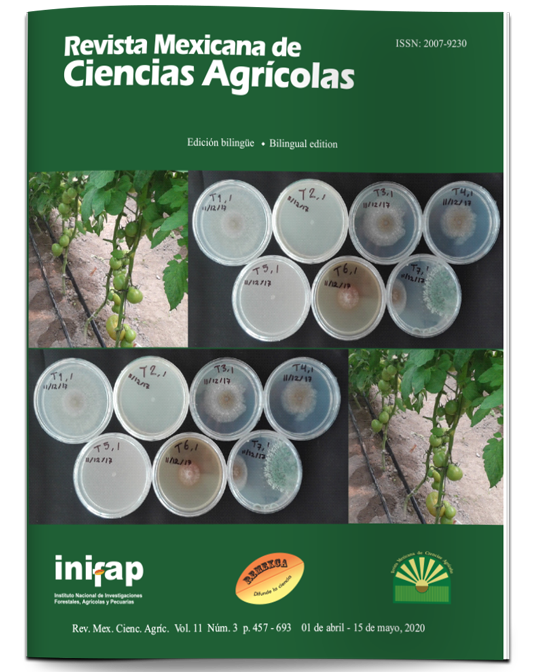Floral stimulation in prickly pear cactus in response to the effect of Thidiazuron
DOI:
https://doi.org/10.29312/remexca.v11i3.1995Keywords:
cladode, floral reversal, lateral sproutingAbstract
On average, the yield of prickly pear (Opuntia ficus-indica) is low, being 5.5 t ha-1 / year. The nopal tuner cladodes have only sprouting in the periphery, representing 30% of total buds / cladode, wasting the lateral spaces of the penca. Using biostimulant in conjunction with plastic cover and irrigation to increase floral budding and yield is the objective of this research. Prickly pear cactus plants ‘Red purpura’ 4 years old, with a planting distance of 3x4 m. There were two factors: 1) Dose of TDZ: 0 ppm, 400 ppm, 800 ppm. 2) Joint plastic cover with irrigation: without cover and without irrigation, without cover and with irrigation, with irrigation and without cover, with irrigation and with cover; in 3x4 factorial arrangement, with 12 treatments and three repetitions in divided plots. The experimental unit was a group of four cladodes. 44 days after applying TDZ, the treatment 800 ppm of TDZ, obtained a higher percentage of flower buds with 53.9%, followed by irrigation cover with 400 ppm of TDZ with 46.8%, exceeding 12.7% of the control. Twenty-two days after the application of TDZ, the plants with plastic cover began to reverse floral and vegetative buds, this phenomenon and the appearance of new shoots, both vegetative and floral, stopped 44 days after applying TDZ, it is suggested that the cover, raised and maintained the temperature to stimulate vegetative sprouting and cause floral reversal.
Downloads
Published
How to Cite
Issue
Section
License
The authors who publish in Revista Mexicana de Ciencias Agrícolas accept the following conditions:
In accordance with copyright laws, Revista Mexicana de Ciencias Agrícolas recognizes and respects the authors’ moral right and ownership of property rights which will be transferred to the journal for dissemination in open access. Invariably, all the authors have to sign a letter of transfer of property rights and of originality of the article to Instituto Nacional de Investigaciones Forestales, Agrícolas y Pecuarias (INIFAP) [National Institute of Forestry, Agricultural and Livestock Research]. The author(s) must pay a fee for the reception of articles before proceeding to editorial review.
All the texts published by Revista Mexicana de Ciencias Agrícolas —with no exception— are distributed under a Creative Commons License Attribution-NonCommercial 4.0 International (CC BY-NC 4.0), which allows third parties to use the publication as long as the work’s authorship and its first publication in this journal are mentioned.
The author(s) can enter into independent and additional contractual agreements for the nonexclusive distribution of the version of the article published in Revista Mexicana de Ciencias Agrícolas (for example include it into an institutional repository or publish it in a book) as long as it is clearly and explicitly indicated that the work was published for the first time in Revista Mexicana de Ciencias Agrícolas.
For all the above, the authors shall send the Letter-transfer of Property Rights for the first publication duly filled in and signed by the author(s). This form must be sent as a PDF file to: revista_atm@yahoo.com.mx; cienciasagricola@inifap.gob.mx; remexca2017@gmail.
This work is licensed under a Creative Commons Attribution-Noncommercial 4.0 International license.



